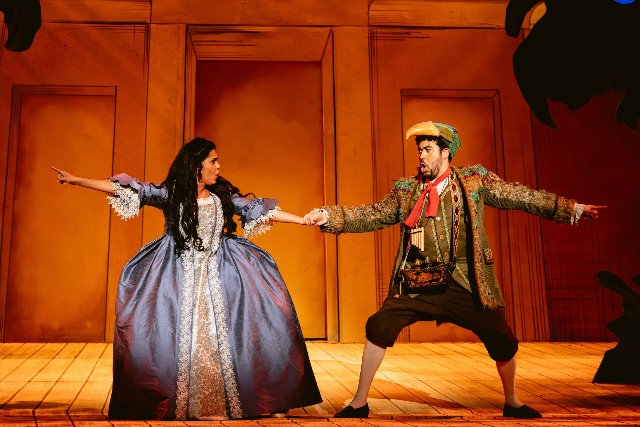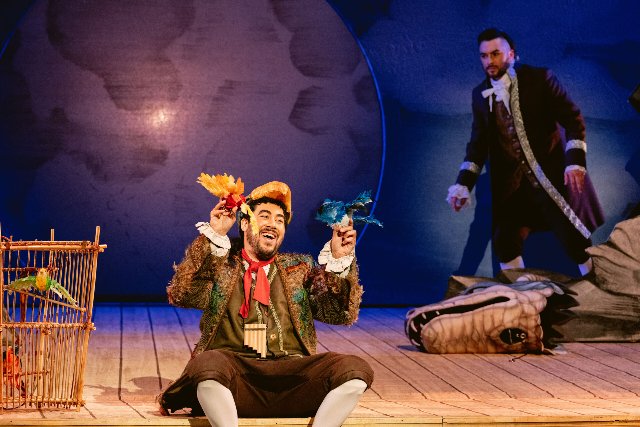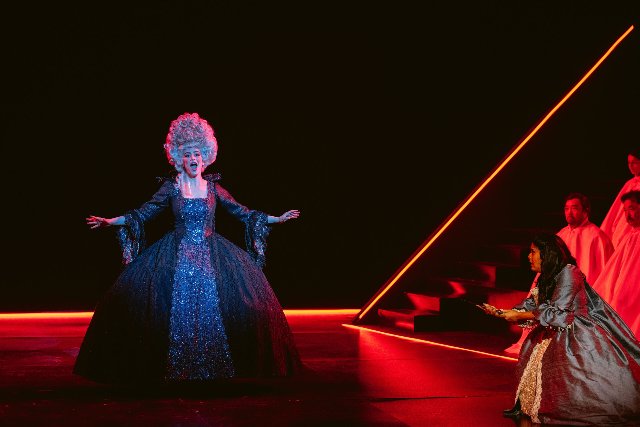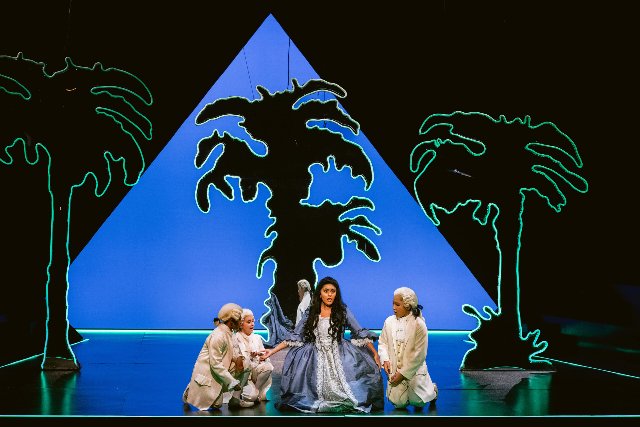The Magic Flute at Opera San Jose
A Compelling Rendering of Mozart's Masterpiece
By: Victor Cordell - Sep 16, 2024
‘Tis the season of the flute. Opera San José offers an innovative, artistically skillful, and highly entertaining production of the mystical opera The Magic Flute (Die Zauberflöte) that should please the full range of patrons from opera aficionados to novices, as it retains the magnificent essential elements while making it highly accessible and understandable.
The Magic Flute presents great opportunity for interpretation, and the Bay Area benefits from a surfeit of contrasting productions of the opera this year. In addition to Opera San José’s splendid rendering, San Francisco Opera radically depicted it as if from the silent film era, using a large flat screen as its canvas and projecting the spoken words as if intertitles from an early film. Soon to come is Berkeley Repertory’s Matchbox Magic Flute, which abbreviates and adapts the work into a form more akin to a stage musical.
As may be construed from these variations, few works in the opera canon are as interpretable as The Magic Flute, not only in how it can be produced, but in what one makes of all of the known and assumed symbols and characters. Because composer and librettist were both Freemasons, many connections (and disconnects) can be inferred from initiation practices in the opera. And because Mozart was Austrian, assumptions may be made that the Queen of the Night represents Maria Theresa and so forth.
In the central plot, Prince Tamino, falls in love with a picture of the Queen of the Night’s daughter, Pamina, who is held captive by High Priest Sarastro. The Queen commits the daughter’s hand to Tamino if he can release Pamina from the Queen’s enemy. The Queen’s bird-catcher Papageno, who also longs for a wife, is enlisted to accompany Tamino on the quest. But Tamino, upon contact, finds Sarastro’s religion appealing and is given the opportunity for induction into the priesthood and to secure Pamina if he passes three trials.
Although there are clear periods of both solemnity and humor in the libretto, the overall dramatic tone can be manipulated to anything from somber and self-important to light-hearted and fairytale-like. Opera San José has chosen the winsome latter appealing approach with an abundance of humanity and frivolity, and it succeeds by all measures.
The lightness achieved in this production begins with the comic flair of much of the acting, particularly of the genial Ricardo José Rivera as the flighty everyman Papageno whose greatest aspiration is simply to relax and enjoy a filling meal. The Three Ladies who collectively act as saviors, facilitators, and provocateurs add a delightful touch with their prodding and probing humor. The comedy extends as well to the overture and other interludes, where considerable pantomime and dance brighten the stage, much of it delivered by charming child performers.
Flute is actually a singspiel with considerable spoken dialog, and here, the company has taken great liberties with mirthful “translations” into English. In one instance, when Papageno’s mouth is padlocked so that he can’t tell lies, the text delivered is “Wouldn’t it be nice if all liars had locks on their mouths?” On opening night, the current political intimation was not lost on the audience, and raucous laughter was punctuated by considerable spontaneous applause.
Ryan McGettigan’s stunning scenic design plays a significant role. In Act 1, the set is comprised largely of pastel, two-dimensional cartoon-like sets that reflect the more carefree earlier period of the opera. An extreme contrast occurs with the more ominous and challenging Act 2. In large measure, the set is a modified black box with neon light framing that intensifies the drama of the latter portions of the narrative.
Of course, for all of this to work, the intriguing but sometimes opaque libretto must be supported by fine music, and who better to provide richly melodious and complex compositions than Mozart. The work sustains interest well until post-climax, when the libretto drags.
Oddly, other than Papageno’s recurring riffs, the most memorable music is given to secondary principals. Most notable is the Queen of the Night’s aria. Emily Misch is developing a career on this role as she conquers the challenging coloratura ornamentation with great ease. Another highlight “O Isis und Osiris,” Sarastro’s deep bass aria that Younggwang Park fully negotiates, but his volume does diminish on the low end.
Conversely, lyric tenor Sergio González who suits the lead role of Tamino well, uses vocal clarity and dynamics effectively, though his controlled pianissimos are sometimes barely audible. Melissa Sondhi turns in a fine performance as Pamina with her agility and lyric tone. A real pleasure is the beautiful tight harmonies of the Three Ladies (Maria Brea, Melissa Bonetti Luna, and Mariya Kaganskaya) – and they are important to the plot. But if the opera belongs to one performer, it is Rivera. As good as his character definition is, his easy baritone warms every lyric it expresses.
A significant event in this performance is the return of 19-year-old Alma Deutscher at the baton, this time conducting a work that she did not compose. She was first here at age 14 for the U.S. premiere of her opera Cinderella and has established quite a strategic partnership with the company. The orchestra performed with admirable tone and precision under her decisive conducting. Kudos also to Director Brad Dalton who brings all of the glorious stage elements together in this sensational production.
The Magic Flute, composed by Wolfgang Amadeus Mozart with libretto by Emanuel Schikaneder is produced by Opera San José and plays at the California Theatre, 345 South 1st Street, San Jose, CA through September 29, 2024.







